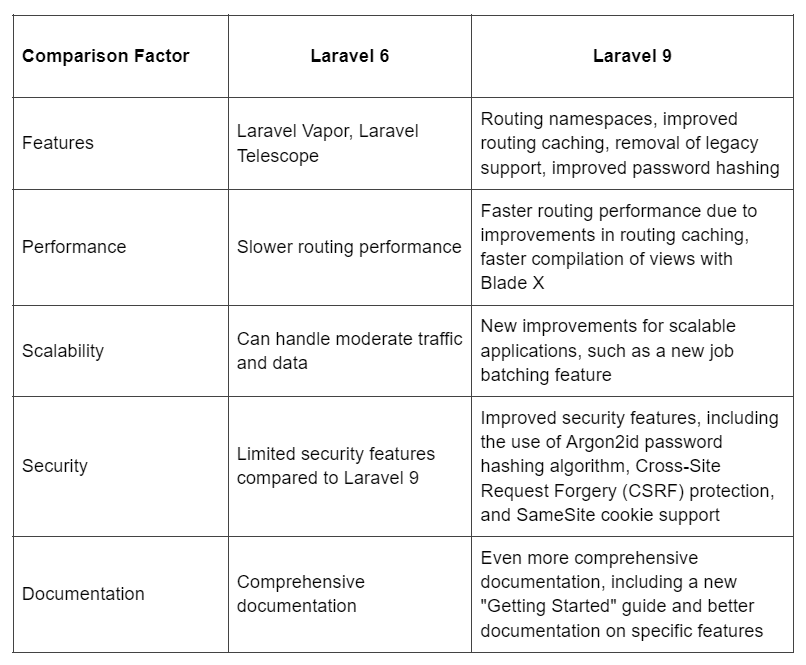A Comprehensive Comparison of Building Web Applications in Laravel 6 & Laravel 9

Laravel is a popular PHP web application framework used for building high-quality web applications. The framework is known for its powerful features and ease of use, making it a popular choice for web application development. Laravel 6 was released in September 2019, while Laravel 9 was released two years later in September 2021. Through this article, we aim to explore the differences between Laravel 6 and Laravel 9 and compare the features, changes, and improvements of each version.
New features in Laravel 9
Laravel 9 introduced several new features and improvements that enhance its capabilities. One of the most significant changes is the introduction of routing namespaces that allows developers to organize their routes into different namespaces for better organization and management. This feature provides a cleaner and more intuitive way to define and group routes, making it easier to maintain large-scale applications.
In the previous versions of Laravel, developers had to manually define prefixes for routes in order to organize them by namespace. This process could become a bit inconvenient and messy, especially for larger applications with several routes. The introduction of routing namespaces in Laravel 9 simplifies this process by allowing developers to specify namespaces for their routes directly.
With routing namespaces, developers can easily group related routes together in a way that makes sense for their application. For example, a developer working on an e-commerce platform might group all of their product-related routes into a “Products” namespace, while all of their order-related routes could be grouped into an “Orders” namespace. This kind of organization helps to keep the routes organized, and it makes it easier for developers to locate and maintain them over time.
Laravel 9 includes improvements to routing caching, which can improve the performance of web applications by reducing the time it takes to resolve routes. By caching route information, Laravel 9 is able to respond to requests more quickly, leading to a faster and more responsive application. This improvement is particularly beneficial for larger applications with many routes, where the time to resolve routes can be a significant bottleneck.
Laravel 9 also removed legacy support for older versions of PHP, which allows developers to take full advantage of the latest PHP features and improvements. Additionally, the framework now supports PHP 8 and it brings numerous enhancements and features such as named arguments, attributes, and constructor property promotion.
Changes in Laravel 6
Laravel 6 introduced several changes and deprecations that impacted how developers use the framework. One significant change was the removal of the “vendor:publish” command. This command was used to publish assets from third-party packages. After the removal of the command, developers now have to manually copy the assets to their application’s public directory.
Another major change in Laravel 6 was the way service providers are loaded. The framework introduced a new method of registering service providers, which streamlined the process and made it more straightforward for developers to load their providers.
Thinking About Migrating from Laravel 6 to Laravel 9?
Migrating from Laravel 6 to Laravel 9 is a straightforward process that can be completed in just a few steps. However, it’s important to follow best practices to ensure a smooth and successful transition.
Developers should first ensure that their application is compatible with PHP 8, as Laravel 9 does not support older versions of PHP anymore. This means that any deprecated code or features must be updated to ensure compatibility with PHP 8.
In addition, developers should thoroughly test their applications after the migration to ensure that all functionality is working as expected. This can include testing both front-end and back-end features, as well as performing load testing and other performance testing to ensure that the application is running smoothly under different conditions.
After the update, developers should test their application thoroughly to ensure that it functions correctly with the new version of Laravel. They should also update their code to take advantage of any new features or enhancements in Laravel 9.
Migrating from Laravel 6 to Laravel 9
Migrating from Laravel 6 to Laravel 9 involves several steps, including updating dependencies, making changes to the application’s code, and testing the application.
1. Update Dependencies:
First, update the version of Laravel in the composer.json file and run the composer update command.
Next, update any other dependencies, such as packages and third-party libraries, to ensure they are compatible with Laravel 9.
2. Make Code Changes:
Verify that your application code is compatible with the latest version of Laravel by running the php artisan laravel:migrate command.
Update any deprecated functions or methods that have been removed in Laravel 9.
Make any necessary changes to the application’s configuration files, such as the .env file.
3. Test the Application:
Test the application thoroughly to ensure whether it is functioning as expected.
Fix any issues that are found during testing.
Tips:
- Keep track of the changes made to the application during the migration process, so that you can revert back to the previous version if needed.
- Create a backup of your application and database before making any changes.
- Use version control to manage the changes made to the application during the migration process.
Best Practices:
- Test the application thoroughly after each step of the migration process to ensure that it is functioning as expected.
- Keep track of all the changes made to the application during the migration process, so that you can revert back to the previous version if needed.
- Use version control to manage the changes made to the application during the migration process.
- Create a backup of your application and database before making any changes.
Comparison of Laravel 6 and Laravel 9
Laravel 9 offers several significant improvements over Laravel 6, and it includes enhanced routing, support for PHP 8, and improved performance. The framework’s new features, such as routing namespaces, provide a more intuitive and streamlined approach to building web applications, making it easier to manage large-scale applications.
Laravel 6 also introduced several changes and deprecations that may impact developers who are used to the older version of the framework. Laravel 6 is still a reliable and powerful framework, but its lack of support for PHP 8 and the removal of the “vendor:publish” command may make it less attractive for developers.

Before We Wind up
Both Laravel 6 and Laravel 9 are powerful frameworks for building web applications, and a Laravel development partner makes the choice here. However, Laravel 9 introduces several new features and enhancements that improve its performance and ease of use, making it the better choice for developers who want to build high-quality web applications.
Laravel web app development services that are currently using Laravel 6 should consider upgrading to Laravel 9 to take advantage of its new features and improvements. However, if the application is not compatible with PHP 8, developers may need to consider other options. The appropriate use case for each version depends on the specific needs and requirements of the project. An application development company should evaluate the features and capabilities of each version carefully to determine which version is the best fit for their application.